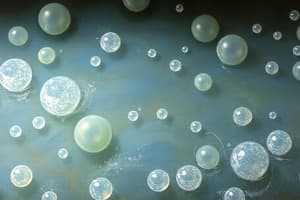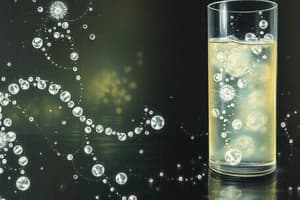Podcast
Questions and Answers
What is the required HLB for emulsifying soybean oil?
What is the required HLB for emulsifying soybean oil?
- 8
- 7 (correct)
- 6
- 9
What is the correct calculation for the required HLB of the oil phase in the lotion described?
What is the correct calculation for the required HLB of the oil phase in the lotion described?
- 10.5
- 9.9
- 10.9 (correct)
- 11.5
If the fraction of mineral oil in the oil phase is 0.86, what is the contribution of mineral oil to the required HLB calculation?
If the fraction of mineral oil in the oil phase is 0.86, what is the contribution of mineral oil to the required HLB calculation?
- 8.5
- 11.1
- 9.03 (correct)
- 10.5
What HLB value is assigned to Tween 40?
What HLB value is assigned to Tween 40?
What is the HLB value of glyceryl monostearate?
What is the HLB value of glyceryl monostearate?
What is the primary characteristic of an oral pharmaceutical emulsion?
What is the primary characteristic of an oral pharmaceutical emulsion?
Which of the following represents a solid emulsion?
Which of the following represents a solid emulsion?
In the context of disperse systems, what type of dispersion medium is used in a solid foam?
In the context of disperse systems, what type of dispersion medium is used in a solid foam?
What is an example of a liquid aerosol?
What is an example of a liquid aerosol?
Which of the following systems has a liquid dispersed phase and a solid dispersion medium?
Which of the following systems has a liquid dispersed phase and a solid dispersion medium?
What is a key attribute of a surfactant solution in terms of foam formation?
What is a key attribute of a surfactant solution in terms of foam formation?
Which of the following examples pertains to a solid aerosol?
Which of the following examples pertains to a solid aerosol?
What type of disperse system would you find in a product like a lotion?
What type of disperse system would you find in a product like a lotion?
What must emulsifiers used in parenteral formulations ensure?
What must emulsifiers used in parenteral formulations ensure?
What is the average droplet size for emulsions used in topical applications?
What is the average droplet size for emulsions used in topical applications?
Which of the following is NOT a group classified for emulsifier selection?
Which of the following is NOT a group classified for emulsifier selection?
Which factor is least important when formulating emulsions?
Which factor is least important when formulating emulsions?
What is the Gibbs free energy change related to in emulsion formation?
What is the Gibbs free energy change related to in emulsion formation?
When is it crucial to sterilize emulsions?
When is it crucial to sterilize emulsions?
Which oil property is NOT a consideration for emulsion formulation?
Which oil property is NOT a consideration for emulsion formulation?
What happens to the possibility of collisions when surfactants are present?
What happens to the possibility of collisions when surfactants are present?
Which of the following is a hydrophilic colloid used as an emulsifier?
Which of the following is a hydrophilic colloid used as an emulsifier?
What is a critical requirement for topical emulsions compared to parenteral emulsions?
What is a critical requirement for topical emulsions compared to parenteral emulsions?
What does the HLB system primarily help to select?
What does the HLB system primarily help to select?
What HLB range is typically associated with oil-in-water (o/w) emulsifying agents?
What HLB range is typically associated with oil-in-water (o/w) emulsifying agents?
Which of the following surfactants has the highest HLB value?
Which of the following surfactants has the highest HLB value?
Which HLB range is likely to be used for anti-foaming agents?
Which HLB range is likely to be used for anti-foaming agents?
Why is the HLB system limited to non-ionic surfactants?
Why is the HLB system limited to non-ionic surfactants?
What does RHLB stand for in the context of the HLB system?
What does RHLB stand for in the context of the HLB system?
Which surfactant has an HLB value closest to 4.7?
Which surfactant has an HLB value closest to 4.7?
What kind of agents fall under the HLB range of 7-9?
What kind of agents fall under the HLB range of 7-9?
What is the HLB value of Tween 60?
What is the HLB value of Tween 60?
Which of the following is NOT a fixed oil mentioned in the content?
Which of the following is NOT a fixed oil mentioned in the content?
What is the calculated Required HLB of the oil phase in the lotion preparation?
What is the calculated Required HLB of the oil phase in the lotion preparation?
If the required HLB for the oil phase is determined to be 11, what is the HLB range for the emulsifiers to be used?
If the required HLB for the oil phase is determined to be 11, what is the HLB range for the emulsifiers to be used?
What is the HLB of Lanolin (Anhydrous) used in the oil phase?
What is the HLB of Lanolin (Anhydrous) used in the oil phase?
Which of the following emulsifiers should be blended to achieve a required HLB of 11, given their HLB values?
Which of the following emulsifiers should be blended to achieve a required HLB of 11, given their HLB values?
What is the contribution of Mineral Oil to the required HLB calculation based on its fraction in the oil phase?
What is the contribution of Mineral Oil to the required HLB calculation based on its fraction in the oil phase?
Which type of disperse system contains a liquid dispersed phase and a liquid dispersion medium?
Which type of disperse system contains a liquid dispersed phase and a liquid dispersion medium?
What is an example of a solid emulsion?
What is an example of a solid emulsion?
Which disperse system is classified as having a gas dispersed phase and a solid dispersion medium?
Which disperse system is classified as having a gas dispersed phase and a solid dispersion medium?
In the context of pharmaceutical emulsions, what is the typical type for oral consumption?
In the context of pharmaceutical emulsions, what is the typical type for oral consumption?
Which of the following examples would classify as a liquid aerosol?
Which of the following examples would classify as a liquid aerosol?
What type of disperse system utilizes a solid as the dispersed phase and a gas as the dispersion medium?
What type of disperse system utilizes a solid as the dispersed phase and a gas as the dispersion medium?
Which characteristic is unique to pharmaceutical emulsions intended for oral use?
Which characteristic is unique to pharmaceutical emulsions intended for oral use?
What is an example of a solid dispersed phase in a liquid suspension?
What is an example of a solid dispersed phase in a liquid suspension?
What is the primary purpose of surfactants in emulsion formation?
What is the primary purpose of surfactants in emulsion formation?
What is a characteristic of parenteral emulsions compared to topical emulsions?
What is a characteristic of parenteral emulsions compared to topical emulsions?
Which of the following classified groups is NOT a type of emulsifier?
Which of the following classified groups is NOT a type of emulsifier?
Why is the selection of emulsifiers very limited for parenteral formulations?
Why is the selection of emulsifiers very limited for parenteral formulations?
Which droplet size is typical for emulsions used in topical applications?
Which droplet size is typical for emulsions used in topical applications?
What role do emulsifying agents play in minimizing globule coalescence?
What role do emulsifying agents play in minimizing globule coalescence?
What is a common property that formulators must consider regarding oil phases in emulsions?
What is a common property that formulators must consider regarding oil phases in emulsions?
What happens to Gibbs free energy ($ΔG^*$) when surfactants are introduced at the oil-water interface?
What happens to Gibbs free energy ($ΔG^*$) when surfactants are introduced at the oil-water interface?
What is the average droplet size maintained in parenteral emulsions?
What is the average droplet size maintained in parenteral emulsions?
Which type of emulsifier is methylcellulose classified under?
Which type of emulsifier is methylcellulose classified under?
What does the HLB system primarily measure in surfactant molecules?
What does the HLB system primarily measure in surfactant molecules?
Which of the following HLB ranges is typically associated with oil-in-water (o/w) emulsifying agents?
Which of the following HLB ranges is typically associated with oil-in-water (o/w) emulsifying agents?
What role do surfactants with an HLB of 15-20 play in formulations?
What role do surfactants with an HLB of 15-20 play in formulations?
What is the significance of the Required HLB (RHLB) in emulsification?
What is the significance of the Required HLB (RHLB) in emulsification?
Which of the following substances would have the lowest HLB value based on the chart provided?
Which of the following substances would have the lowest HLB value based on the chart provided?
In the HLB system, what is the primary function of emulsifiers with an HLB range of 3-6?
In the HLB system, what is the primary function of emulsifiers with an HLB range of 3-6?
Which fixed oil is listed in the content as an example?
Which fixed oil is listed in the content as an example?
Which of the following surfactants has an HLB value closest to 15?
Which of the following surfactants has an HLB value closest to 15?
Why is the HLB system important for non-ionic surfactants specifically?
Why is the HLB system important for non-ionic surfactants specifically?
What does an HLB value of 7-9 indicate about a surfactant's function?
What does an HLB value of 7-9 indicate about a surfactant's function?
Flashcards
Disperse System
Disperse System
A system where one substance (dispersed phase) is evenly spread throughout another substance (continuous phase).
Interface
Interface
The boundary between two immiscible phases, like oil and water.
Continuous Phase
Continuous Phase
The substance that surrounds and disperses the dispersed phase.
Dispersed Phase
Dispersed Phase
Signup and view all the flashcards
Suspension
Suspension
Signup and view all the flashcards
Emulsion
Emulsion
Signup and view all the flashcards
Pharmaceutical Emulsion (Oral)
Pharmaceutical Emulsion (Oral)
Signup and view all the flashcards
Oil/Supplement Emulsion
Oil/Supplement Emulsion
Signup and view all the flashcards
Required HLB
Required HLB
Signup and view all the flashcards
HLB System
HLB System
Signup and view all the flashcards
Fraction of Oil Phase
Fraction of Oil Phase
Signup and view all the flashcards
Required HLB Calculation
Required HLB Calculation
Signup and view all the flashcards
HLB Blending
HLB Blending
Signup and view all the flashcards
Oil-in-Water (O/W) Emulsion
Oil-in-Water (O/W) Emulsion
Signup and view all the flashcards
Water-in-Oil (W/O) Emulsion
Water-in-Oil (W/O) Emulsion
Signup and view all the flashcards
Gibbs Free Energy (ΔG*)
Gibbs Free Energy (ΔG*)
Signup and view all the flashcards
Surfactants
Surfactants
Signup and view all the flashcards
Globule Coalescence
Globule Coalescence
Signup and view all the flashcards
Emulsion Destabilization
Emulsion Destabilization
Signup and view all the flashcards
Surface Active Agent
Surface Active Agent
Signup and view all the flashcards
Finely Divided Solids
Finely Divided Solids
Signup and view all the flashcards
Hydrophilic Colloids
Hydrophilic Colloids
Signup and view all the flashcards
HLB Value
HLB Value
Signup and view all the flashcards
Surfactant Action
Surfactant Action
Signup and view all the flashcards
Required HLB (RHLB)
Required HLB (RHLB)
Signup and view all the flashcards
Hydrophilic Surfactants
Hydrophilic Surfactants
Signup and view all the flashcards
Lipophilic Surfactants
Lipophilic Surfactants
Signup and view all the flashcards
Tween 60
Tween 60
Signup and view all the flashcards
Span 60
Span 60
Signup and view all the flashcards
HLB Values of Common Surfactants
HLB Values of Common Surfactants
Signup and view all the flashcards




